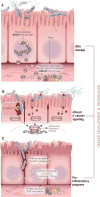Cancer and the microbiota
- PMID: 25838377
- PMCID: PMC5535753
- DOI: 10.1126/science.aaa4972
Cancer and the microbiota
Abstract
A host's microbiota may increase, diminish, or have no effect at all on cancer susceptibility. Assigning causal roles in cancer to specific microbes and microbiotas, unraveling host-microbiota interactions with environmental factors in carcinogenesis, and exploiting such knowledge for cancer diagnosis and treatment are areas of intensive interest. This Review considers how microbes and the microbiota may amplify or mitigate carcinogenesis, responsiveness to cancer therapeutics, and cancer-associated complications.
Copyright © 2015, American Association for the Advancement of Science.
Figures




References
Publication types
MeSH terms
Grants and funding
LinkOut - more resources
Full Text Sources
Other Literature Sources
Medical

